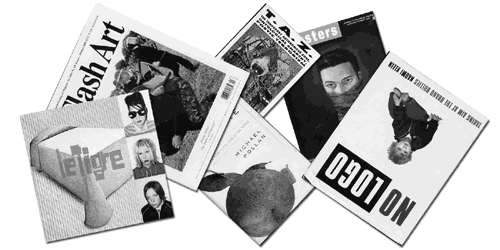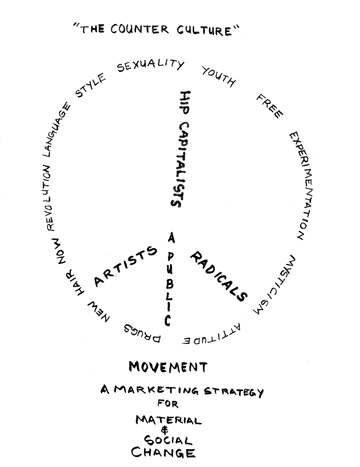Counter Cultural Dialectics
Robby Herbst
The following is an adapted transcript
of a slide lecture developed through three events held by Nomads_Residence
LA, Soft Skull Press, and 16 Beaver Street.

What is to be made of the proliferation
of protests? What do all these books, ideas, and actions add
up to? Does the totality of practices we are all engaged in
mean something other than a collection of memories? This question
asks of broader contexts, of a conside-ration of the concept
of counter culture movements. To this end I made a diagram
“Counter Culture Dialectics”.
In the diagram,
I mapped out two distinct meta-forms for the conceptualization
of counter culture. Within these two forms I have outlined four
distinct historical phases. The fourth phase is rumination on
the contemporary moment; a speculation on emerging trends. Although
the diagram can be read as a historical progression, it should
be realized that the aesthetic forms that it describes are often
ongoing and concurrent. That is, an artist today might be working
in a very relevant and productive space, but their practice
may carry on previous dialectics. An example here would be Michael
Moore – whose relationship to mediation ties him to the
heroic uses of “mainstream” media developed by Abbie
Hoffman.
On the diagram, you can see two distinct halves. One side can
be described as the formulation of the Modern conception of
a counter culture. The other half would be the Post-modern conception
of counter culture. Here it should more accurately be referred
to as “Counter Cultures”. Because, as a bridge –
and fueling transition between the two – is a singular,
“The Counter Culture”. This is best thought of as
the distinct movement commonly referred to as the “Sixties”
or “Hippy Culture.”
Modern counter culture is one
based on the preconception of maintained cultural hierarchies,
where there are clear boundaries defining culture that is either
“In or Out”, “High or Low”, “Hip
or Square”.
These boundaries are maintained not only
by economies of scale but by laws in the form of: blue laws,
institutionalized racism, market protectionism, institutionalized
sexism, red squads, hide bound socio-cultural traditions.
In this diagram, a boundary of conflict
between “In” and “Out” is maintained
by the psyche’s dialectic of behavior, “the Freaks
vs.the Squares.” The other boundary is the one over property
which in terms of art is an argument of culture’s marketability
vrs culture’s universality; “the Man vs. the Radicals.”
Within the Modernist structure, the oppositional nature of the
phrase “counter culture” is very fitting. Because
of the in/out structure of law, it is easy and functional to
locate transgressive culture. If shouting “motherfucker”
on a rock record is illegal, then it is clearly counter cultural
to swear, or likewise, to censor. This was the case for the
band MC5 and later for artists Ron Athey and Karen Finley, who,
much to their surprise, found themselves in a battle with lawmaker
Jessie Helms.
The second of the two meta-structures of counter culture is
“Post-modernism”. In this structure, there are no
laws maintained to define hierarchical culture. Instead there
are policies that support market deregulation and the defunding
of the arts on one hand, and racial and gender integration on
the other. These policies have turned to create an individualized
and rhizomatic structure.
This structure is The Bafflers’ world
of nothing for cultural actors to rebel against in a world where
there are no clearly defined walls to push against. This is
the terrain of the sub-culture, of Marcusian heading towards
and claiming the margins to create the alternative society,
Herland, the gay neighborhood, Ecotopia.
The first of the four phases of counter culture mapped out here
would be that of the modernist avant-gardes who fought battles
on clearly defined fields of conflict. One example is the Surrealist
battle on the front of human consciousness. Another is Dadaist
war on the temples of culture.
The second historical phase mapped out here
is an American invention, The Counter Culture, dated somewhat
randomly in the diagram as 1965-1970. This phase is unique because
of its creation by and use of contemporary media. Thus, it later
helped to shape the post-modern landscape.
 |
The Counter Culture is defined by its Faustian bargain
with “the Man”, which required a no-nothing
attitude towards certain repressions. The affluence
of the post-war generation led to the politics of “FREE,”
a movement conceptua-lizing a “Post-Scarcity”
society, where resources (libidinal or material) were
in excess.
The “green revolution” in agriculture,
the greater dispersal application and affordability
oftechnology and the rise of the leisure class in the
“first world” led to the belief that a society
was being birthed which could overcome any problem through
the application of radical thought and innovative cultural
action.
|
The FM radio is a perfect metaphor for The
Counter Culture. FM radio, seeping dewy-wet, freely across the
American landscape, could cross cultural communities broadcasting
sounds of youth through racial and economic lines. What once
was black music could now be suburban music and vice-versa.
The dependence on this and other capitalist technological innovations
made The Counter Culture a factitious scene with space for anti-materialist
way out freaks like the Diggers of San Francisco and that city’s
hip capitalist promoter, Bill Graham.
There are certain aesthetic tropes to which The Counter Culture
was beholden. Since the movement was trend-oriented rather than
programmatic, this assertion and the following ones should not
be taken as absolutes. However, works produced in The Counter
Culture tended to: romanticize revolution, were absorbed with
the “new” and “youth” whom represented
it, fetishized the other, and emphasized sensuality and sexuality.
New forms of electronic reproduction, distribution, and mediation
was a phenomena often commented upon, emphasized, naturalized,
romanticized, or problematized within works of the movement.
The Counter Culture was in some respects itself a Pop Art movement
fascinated with the process of its own mediation.
1 | 2
| 3 | next
>

